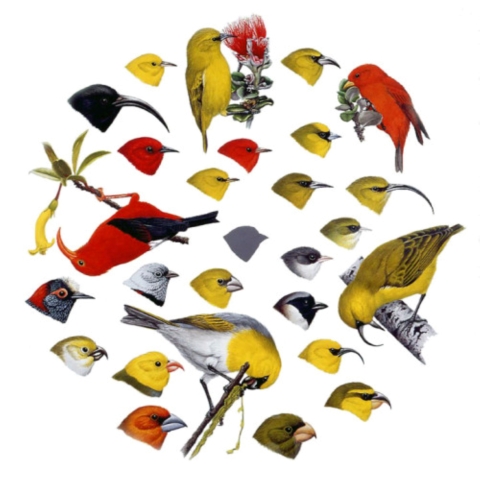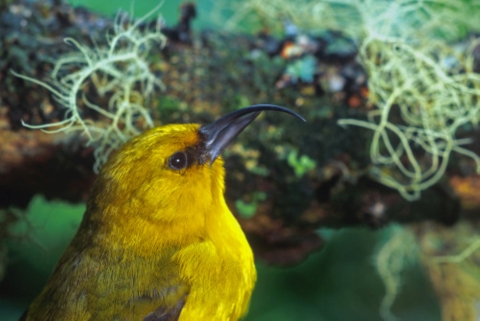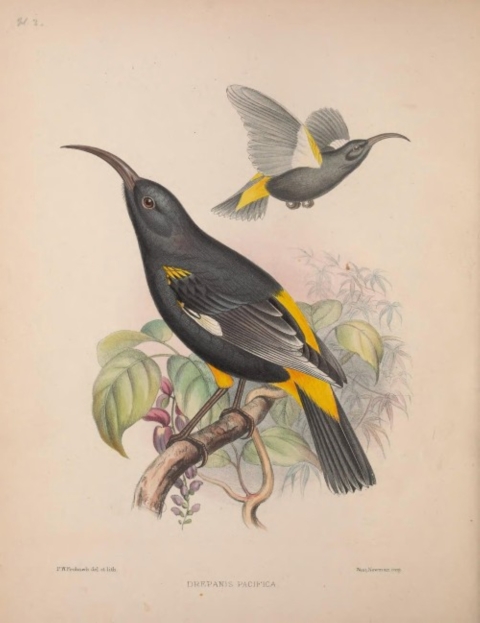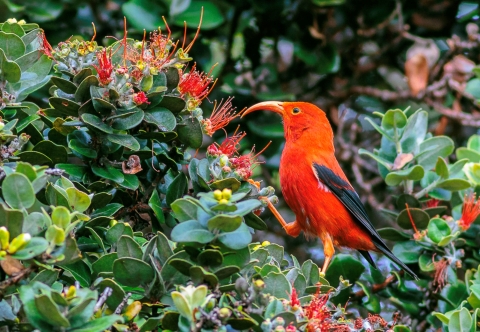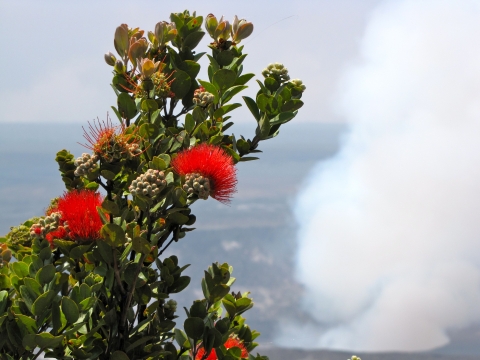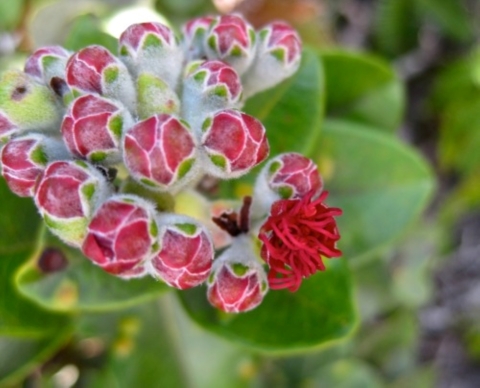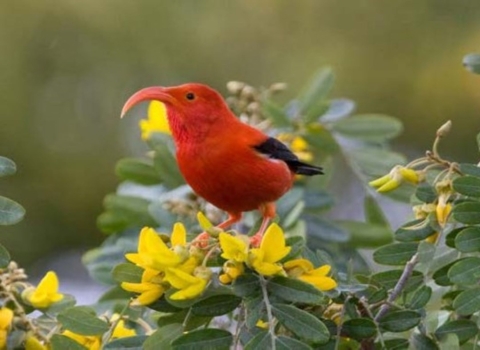This year is the 50th anniversary of the Endangered Species Act, a law that has been a powerful catalyst for conservation of America’s most treasured fish, wildlife, plants and their habitats. In the Pacific Region, our Tribes, state and federal agencies, and partners have joined with our dedicated staff to be the driving force behind the successes we share and the strength ensuring we can address the challenges ahead. Celebrate this milestone with us in this collection of stories as we reflect on past successes, assess current challenges, and envision an equally bright future for the next 50 years and beyond.
This is the first in a series of articles examining the issues impacting Hawaiʻi’s forest birds.
Around six million years ago, a small ancient species of finch found its way to the most remote archipelago in the world. Over 2,000 miles from the nearest major land source, and uninhabited by humans or any other mammals, the small islands of Hawaiʻi were a blank canvas just waiting to be filled with a brand new family of birds - the Hawaiian honeycreepers. The story of the Hawaiian honeycreepers is one of the most beautiful and complex examples of adaptive radiation in evolutionary history.
For millions of years, the birds thrived on the tiny islands in the Pacific. There were no mammals, no humans, few other species to compete with, and a great diversity of habitats. The first honeycreepers arrived on ancient islands that have since eroded away. As each new island in the chain rose from the sea and cooled the tiny birds colonized it, splitting off into dozens of new subspecies along the way. Each split in the family tree yielded more complexity and novel ways to find food, attract a mate, and fill an ecological niche.
From their beginning, the honeycreepers were shaped and molded by the unique landscape of the islands themselves.
Fossil records show that at one time there were as many as 50 species of honeycreepers in the Hawaiian Islands, each with unique adaptations their particular ecological niche. But changing ecosystems have not bee kind to the birds, today only 17 species of honeycreeper remain. They have been pushed out by invasive species invasive species
An invasive species is any plant or animal that has spread or been introduced into a new area where they are, or could, cause harm to the environment, economy, or human, animal, or plant health. Their unwelcome presence can destroy ecosystems and cost millions of dollars.
Learn more about invasive species , habitat loss, and introduced diseases.
Unfortunately, all of this magnificent diversity can also be a limitation if the habitat or the environment changes.
“A lot of the very specialized birds that had the most unique characteristics were the first to go extinct once the habitat started changing,” said Steve Kendall, wildlife biologist for Hakalau Forest National Wildlife Refuge.
From: Birds of the Sandwich Islands, By Wildon Scott (1899)
Courtesy of the Smithsonian Institute
One of the most spectacular members of the honeycreeper family is the ‘iʻiwi (Drepanis coccinea, pronounced /iːˈiːviː/, ee-EE-vee). Their long curved bill and distinctive red and black plumage have become iconic symbols of Hawaiian natural and cultural heritage.
In the early 1800’s naturalists describe flocks of ‘iʻiwi flying up and down the mountain slopes of the Hawaiian Islands foraging on nectar and insects. Today they are rarely seen below 4,000 feet, and are restricted to narrow bands of high elevation forests.
Their long curved bill matches the size and shape of the flowers of the lobeliad family. Lobeliads were once found all over the islands, but like so many of Hawaii’s native species, those plants have become scarce. To survive, the ‘i’Iwi has had to turn to another iconic Hawaiian species for their survival - the mighty ʻōhiʻa lehua.
ʻŌhiʻa form the backbone of Hawaiʻi’s native forest ecosystems, and for the ‘iʻiwi they have come to mean survival. The flowers of the ʻōhiʻa lehua tree are now the primary source of food for ‘iʻiwi, and the birds spend 80% - 90% of their time foraging in ʻōhiʻa forests.
Unlike the honeycreepers, which evolved to fill highly specialized niches in the environment, the ʻōhiʻa lehua are decidedly generalist. ʻŌhiʻa are one of the most common trees in Hawaiʻi. They are also the first trees to colonize lava fields after eruptions, and not surprisingly they can withstand high levels of toxic volcanic gasses.
‘Ōhi'a can be found from sea level all the way up to the tree line at around 8,000 ft. Not only do the trees thrive in an incredible diversity of soil types and climates conditions, but they also grow in a variety of sizes and colors.
In a rapidly changing Hawaiian ecosystem, ʻōhiʻa lehua forests have become a lifeline for many of Hawaiʻi’s forest birds who rely on the abundant tree for either food or shelter.
Serious challenges are on the horizon for both the ʻiʻiwi and the ʻōhiʻa lehua. Avian malaria, a disease spread by invasive mosquitoes is impacting many of Hawaiʻi’s forest birds, but few species are as susceptible to the disease as the ʻiʻiwi, which can have a fatality rate from the disease as high as 90%. As a result of the spread of avian malaria across the lower elevations of the islands, the ʻiʻiwi have all but disappeared below 4,000 feet.
For now, ʻiʻiwi have found refuge from the disease in the cooler high elevation ʻōhiʻa lehua forests of places like Hakalau Forest National Wildlife Refuge, where decades of habitat restoration are showing signs of success.
Next in the series:
We explore how avian malaria is changing the sights and sounds of Hawaii’s forests, even as scientists and conservationists across Hawaii are working together to find solutions.
###
The U.S. Fish and Wildlife Service works with others to conserve, protect, and enhance fish, wildlife, plants, and their habitats for the continuing benefit of the American people. For more information, visit www.fws.gov/pacificislands, or connect with us through any of these social media channels at https://www.facebook.com/PacificIslandsFWS, www.flickr.com/photos/usfwspacific/, https://medium.com/usfwspacificislands or www.twitter.com/USFWSPacific.


